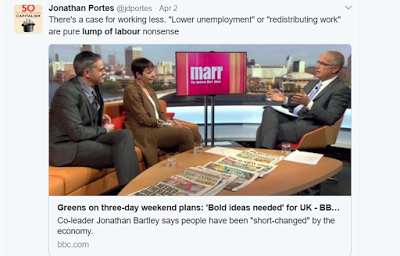By Sandwichman Thank God it’s Boilerplate!: It’s Thursday and The Economist is lumping its labour The Economist and Jonathan Portes are at it again. “Lump of labor! Lump of labor!” The occasion? A proposal for a four-day workweek announced by the U.K. Green Party at their convention this week in Liverpool. The Economist pretended to find “two problems” with the Greens’ proposal: The Greens’ proposals encounter two problems. First, the theory. They argue that the reduced hours worked by some could be redistributed to others in order to lower underemployment. They thus fall prey to the “lump of labour fallacy”, the notion that there is a fixed amount of work to be done which can be shared out in different ways to create fewer or more jobs. In fact, if people worked fewer hours, demand would drop, and so fewer working hours would be on offer. Second, the cost. Increased productivity could cover some of the costs of paying a five-day wage for a four-day week, suggests Sarah Lyall of the New Economics Foundation, a think-tank. She points to a Glasgow marketing company that did just that, and experienced a 30% leap in productivity. But that is an astonishing increase to expect across the board. First the theory: why does the idea of redistributing work require a “fixed amount of work to be done”? I can cut up a pie in many different ways.
Topics:
Dan Crawford considers the following as important: Journalism, politics, Taxes/regulation, US/Global Economics
This could be interesting, too:
Robert Skidelsky writes Lord Skidelsky to ask His Majesty’s Government what is their policy with regard to the Ukraine war following the new policy of the government of the United States of America.
Joel Eissenberg writes No Invading Allies Act
Ken Melvin writes A Developed Taste
Bill Haskell writes The North American Automobile Industry Waits for Trump and the Gov. to Act
by Sandwichman
Thank God it’s Boilerplate!: It’s Thursday and The Economist is lumping its labour
The Economist and Jonathan Portes are at it again. “Lump of labor! Lump of labor!” The occasion? A proposal for a four-day workweek announced by the U.K. Green Party at their convention this week in Liverpool.
The Economist pretended to find “two problems” with the Greens’ proposal:
The Greens’ proposals encounter two problems. First, the theory. They argue that the reduced hours worked by some could be redistributed to others in order to lower underemployment. They thus fall prey to the “lump of labour fallacy”, the notion that there is a fixed amount of work to be done which can be shared out in different ways to create fewer or more jobs. In fact, if people worked fewer hours, demand would drop, and so fewer working hours would be on offer.
Second, the cost. Increased productivity could cover some of the costs of paying a five-day wage for a four-day week, suggests Sarah Lyall of the New Economics Foundation, a think-tank. She points to a Glasgow marketing company that did just that, and experienced a 30% leap in productivity. But that is an astonishing increase to expect across the board.
First the theory: why does the idea of redistributing work require a “fixed amount of work to be done”? I can cut up a pie in many different ways. I can also cut two, three, many pies in different ways. In what sense does redistribution imply a constant amount? It doesn’t.
Furthermore, what does The Economist mean by “fixed”? The word seems to refer to a constant or unchanging amount. It is unlikely that it means “repaired,” as in the amount of work used to be broken but now it is fixed.” But there is third possible meaning of fixed that is very significant: a quantity that is determined or regulated by a proportion. Here is an example of this usage from a 19th bankers’ magazine: “it is the proportion between supply and demand that fixes the price of the metal.” Here is another example: “the market price of cotton is fixed by the proportion between the demand and the supply.” A third example: “It has been always understood, that the price of commodities is fixed by the proportion between the demand and the supply.”
The word “fixed” thus has a well-established place in partial equilibrium analysis. It refers to a proportional relationship between supply, demand and price. Thus a “fixed amount of work to be done” could conceivably refer to a variable quantity whose variation is regulated by the wage rate. This, of course, is the (partial equilibrium) argument trotted out perennially by opponents of the minimum wage. This is also the logic behind the argument that markets are self-adjusting and will clear, provided that prices are flexible.
It short, the lump-of-labor “fallacy” claim hinges on a deceptive ambiguity. It is a bamboozle. But apparently not enough of a bamboozle for The Economist, which doubled down with a second sleight of rhetorical hand, “the cost.” The Greens’ argument was that productivity could cover some of the cost. The New Economics Foundation cited an exemplary productivity gain of 30% at a Glasgow marketing company. The Economist harrumphed the whole argument away by sneering that it is “an astonishing increase to expect across the board.”
Did anyone claim that such an increase was expected across the board? No. Would such an increase across the board be needed to cover some of the cost? No.


